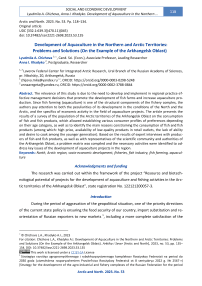Development of Aquaculture in the Northern and Arctic Territories: Problems and Solutions (On the Example of the Arkhangelsk Oblast)
Автор: Chizhova L.A., Khadyko A.I.
Журнал: Arctic and North @arctic-and-north
Рубрика: Social and economic development
Статья в выпуске: 53, 2023 года.
Бесплатный доступ
The relevance of this study is due to the need to develop and implement in regional practice effective management decisions that promote the development of fish farms and increase aquaculture production. Since fish farming (aquaculture) is one of the structural components of the fishery complex, the authors pay attention to both the peculiarities of its development in the conditions of the North and the Arctic, and the specifics of economic activity in the field of aquaculture projects. The article presents the results of a survey of the population of the Arctic territories of the Arkhangelsk Oblast on the consumption of fish and fish products, which allowed establishing various consumer profiles of preferences depending on their age category, as well as to identify the main reasons constraining the consumption of fish and fish products (among which: high price, availability of low-quality products in retail outlets, the lack of ability and desire to cook among the younger generation). Based on the results of expert interviews with producers of fish and fish products, as well as with representatives of the scientific community and authorities of the Arkhangelsk Oblast, a problem matrix was compiled and the necessary activities were identified to address key issues of the development of aquaculture projects in the region.
North, Arctic region, socio-economic development, fisheries, fish industry, fish farming, aquaculture
Короткий адрес: https://sciup.org/148329493
IDR: 148329493 | УДК: [332.1:639.3](470.11)(045) | DOI: 10.37482/issn2221-2698.2023.53.135
Текст научной статьи Development of Aquaculture in the Northern and Arctic Territories: Problems and Solutions (On the Example of the Arkhangelsk Oblast)
During the period of aggravation of the geopolitical situation, one of the priority directions of the current state policy is ensuring the food security of our country, import substitution and reorientation of Russian exporters to new markets 1, including a more complete satisfaction of the
-
∗ © Chizhova L.A., Khadyko A.I., 2023
This work is licensed under a CC BY-SA License needs of the domestic market. Traditionally, issues of food security in the northern and Arctic territories of Russia are associated with the work of enterprises in the fishery complex, including both fishing sector and fish farming (aquaculture projects). Fish and fish products are included in the mandatory diet of the population of the North and the Arctic, which is determined both by the eating habits of the local population and the undeniable benefits of fish products, and by the presence of a large number of water bodies with quite significant amounts of resources. However, despite this, the development of both freshwater and marine aquaculture in the Arctic regions of Russia remains at a rather low level. At the same time, in global practice over the past decades, aquaculture has been the fastest growing sector of food production. It should be noted that according to the results of a number of studies [1, Kozenko Z.N., Kozenko K.Yu., Vorobyov N.N.; 2, Ermakova N.A., Micheles T.V.], Russia has both an extensive domestic market and significant reserves for the development of aquaculture projects.
The northern and Arctic regions of the Russian Federation are an area of risky agriculture and, due to harsh climatic conditions, have a number of restrictions in food production. That is why today their territories are often dominated by imported products, which, unfortunately, are not always distinguished by high quality characteristics. The problems of providing the population with fresh and high-quality food, including fish and fish products, issues of food security are described in detail in a number of works by domestic and foreign scientists [3, Ivanov V.A.; 4, Sukhanov G.G., Sukhanov S.G.; 5, Moriarity R.J., Liberda E.N., Tsuji L.J.S.].
The most important stage preceding the sale of fish and fish products to the population is processing. For example, in Norway, only 44% of fish caught is processed and put on the market (mostly fillets); the remaining 56% could be used to produce animal feed [6, Hjellnes V., Rustad T., Falch E.]. However, since most foreign and domestic fishing vessels do not have special equipment, the extracted aquatic biological resources are not used effectively enough.
In our opinion, the practical aspects of the formation and transformation of the consumer market in the Arctic regions deserve special attention, because “... the level of personal consumption and the level of development depend on the state of the consumer market, including the level of prices for the most important goods and services, their range and quality production relations, stability of money circulation, standard of living of the population...” [7, Tutygin A.G., Chizhova L.A., Urykov V.A., p. 77].
Taking into account the above, we considered it relevant to conduct a sociological study of the preferences of consumers and producers of fish products using the example of the Arctic municipalities of the Arkhangelsk Oblast in order to identify problems and opportunities for the development of the corresponding sector of the consumer market. Therefore, within the framework of this article, using scientific research methods such as comparative analysis, systems approach, statistical data analysis, survey, expert assessments, we will further consider the following: the until 2030 (approved by Decree of the Government of the Russian Federation dated September 8, 2022 No. 2567-r)]. URL: (accessed 07 April 2023).
SOCIAL AND ECONOMIC DEVELOPMENT
Lyudmila A. Chizhova, Anna I. Khadyko. Development of Aquaculture in the Northern … features of the development of the fisheries complex of the northern and Arctic regions of Russia; the results of a survey conducted by the authors of the population of the Arctic territories of the Arkhangelsk Oblast on the consumption of fish and fish products; the final conclusions of expert interviews taken from representatives of the management of the fishing industry enterprises of the Arkhangelsk Oblast, government bodies and business support institutions, and the scientific community in order to identify key problems and opportunities for the development of aquaculture projects in the region.
Features of the development of the fishery complex of northern and Arctic regions of Russia
Northern fishing has a rich history; for example, back in the 10th–12th centuries, the first Russian navigators began to develop lands on the coasts of the White and Barents Seas, where they were engaged in fishing, fur and sea animals hunting [8, Lobanov K.V., Chicherov M.V., pp. 41–42]. Even before the reign of Ivan the Terrible, products of Pomor fisheries were sold to other regions of Rus', and under Ivan the Terrible, international fairs began to be held in Arkhangelsk, and Pomor goods were sold to other countries 2.
According to historical data, in 1905, there were about 29 thousand industrialists in Arkhangelsk, who annually harvested more than 8.6 thousand tons of fish [9, p. 23]. However, in 1918, the fishing industry of the Arkhangelsk Oblast faced the problem of dilapidated and technically backward vessels. But the Soviet government quickly found a solution to this issue, and at the end of June 1920, the first trawler started operating in Arkhangelsk. In 1937, Arkhangelsk fisheries enterprises already had 12 trawlers, 137 units of motor and more than 2 thousand units of sailing rowing fleet, the service infrastructure was also built. Only due to these efforts it was possible to increase the volume of fish production from 12.9 thousand tons in 1932 to 37.3 thousand tons in 1936 [9, p. 43].
The Soviet state has achieved significant success in the production of fish and other aquatic biological resources; for example, in the Arkhangelsk Oblast over the forty-year period from 1940 to 1980, this volume was increased 10 times, then a steady downward trend in volumes was observed (Fig. 1).
СП
О 300
С 250 га
(Л
_с 200
Е- 150
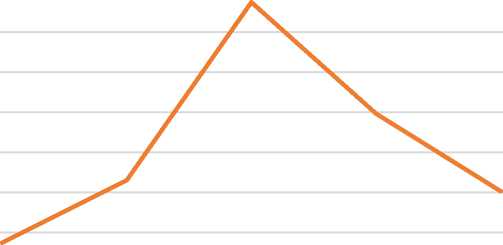
Year
.
Fig. 1. Fishing and production of other aquatic bioresources in the Arkhangelsk Oblast, thousand tons 3, 4.
If we look at the current situation, the absolute leader in terms of production of fish and other aquatic biological resources among the Arctic regions of Russia is the Murmansk Oblast. The Arkhangelsk Oblast and the Republic of Karelia occupy second and third places in this list of regions, respectively. It should be noted that for the period 2017–2022, an increase in the production rate is typical only for the Republic of Karelia (Fig. 2).
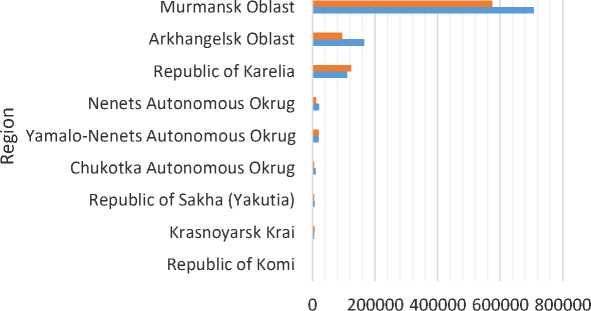
■ 2022
■ 2017
Tons
Fig. 2. Fishing and production of other aquatic bioresources in the Arctic zone of the Russian Federation (including fish farming), tons 5.
At the same time, the current state of fishing volumes in the Arkhangelsk Oblast is below the level of 1960 and more than three times lower than the peak level of 1980.
Recently (in the early 2000s), a relatively new type of activity for domestic enterprises of the fishing industry started to develop — fish farming. Undoubtedly, there are significantly fewer enterprises engaged in fish farming in the Arctic regions of Russia than enterprises specializing in fishing, and this is quite natural (Table 1).
Table 1
Number of enterprises engaged in fishing and fish farming in the Arctic regions of Russia 6
|
Fishing |
Fish farming |
∆ 2020–2005 |
||||
|
2005 |
2020 |
2005 |
2020 |
Fishing |
Fish farming |
|
|
Republic of Karelia |
69 |
41 |
64 |
104 |
-28 |
40 |
|
Republic of Komi |
4 |
8 |
16 |
11 |
4 |
-5 |
|
Nenets Autonomous Okrug |
16 |
21 |
0 |
0 |
5 |
0 |
|
Arkhangelsk Oblast |
80 |
44 |
11 |
8 |
-36 |
-3 |
|
Murmansk Oblast |
448 |
184 |
22 |
25 |
-264 |
3 |
|
Yamalo-Nenets Autonomous Okrug |
38 |
61 |
0 |
3 |
23 |
3 |
|
Krasnoyarsk Krai |
64 |
69 |
6 |
20 |
5 |
14 |
|
Republic of Sakha (Yakutia) |
69 |
125 |
5 |
8 |
56 |
3 |
|
Chukotka Autonomous Okrug |
15 |
61 |
6 |
1 |
46 |
-5 |
|
Total |
803 |
614 |
130 |
180 |
-189 |
50 |
If the leader in the field of fishing (as noted above) among the Arctic regions of Russia is the Murmansk Oblast, then the first place in the field of fish farming belongs to the Republic of Karelia. In the Arkhangelsk Oblast, unlike other regions of the Russian Arctic, the number of both fishing and fish farming enterprises has decreased over the last 15 years. However, in recent years in the Arkhangelsk Oblast, there has been an increase in production volumes by fish farming enterprises with accompanying government support (Table 2).
Table 2
State support for fish farming companies in the Arkhangelsk Oblast 7
|
Indicators |
Year |
|||||
|
2017 |
2018 |
2019 |
2020 |
2021 |
2022 |
|
|
Subsidy for feed (million rubles) |
1.9 |
3.0 |
4.4 |
8.4 |
6.8 |
7.4 |
|
Subsidy for fish seeding material (million rubles) |
0.2 |
0.4 |
0.6 |
0.7 |
2.8 |
1.9 |
|
Subsidy for aquaculture equipment* (million rubles) |
- |
- |
- |
- |
- |
3.5 |
|
Number of fish farms received state support (units) |
3 |
4 |
4 |
4 |
6 |
8 |
|
Planned production volume (tons) |
- |
- |
130 |
130 |
230 |
260 |
|
Actual production volume (tons) |
111 |
130 |
173 |
221 |
260 |
332 |
* Note: equipment subsidy was introduced in 2022.
In 2022, all fish farming enterprises in the Arkhangelsk Oblast, without exception, took advantage of government subsidies for their activities.
Study of the consumer market for products of the regional fishing industry (results of a survey of the population of the Arctic territories of the Arkhangelsk Oblast)
In order to study the peculiarities of fish and fish products consumption by the residents of the Arctic territories of the region, we conducted a sociological study using Yandex.Forms in the period from January 24 to April 3, 2023. The survey used a quota sampling method, where the criteria for dividing respondents into groups were place of residence and statistical proportions of the population for working citizens and pensioners [10, p. 167]. The sample consisted of 400 peo-
-
6 Regions of Russia. Socio-economic indicators. 2022.
URL:
https://rosstat.gov.ru/storage/mediabank/Region_Pokaz_2022.pdf (accessed 18 April 2023).
-
7 Data provided by the Ministry of Agriculture and Trade of the Arkhangelsk Oblast.
ple from the Arctic municipalities of the Arkhangelsk Oblast, of which 71% were workers and 29% were pensioners. Figure 3 shows the structure of respondents according to their place of residence in the Arkhangelsk Oblast.

Fig. 3. Structure of respondents by geographical feature.
The survey showed that almost a third of respondents consume fish and fish products quite often (almost every day or 1-2 times a week). Rare consumption of such products was noted by 28% of respondents (Fig. 3).
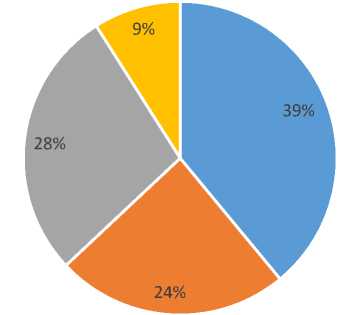
-
■ At least 2 times a month
-
■ 1-2 times a week
-
■ Less than 2 times a month
-
■ Almost every day
Fig. 4. Frequency of consumption of fish and fish products.
The most popular answer was “at least 2 times a month” — it received 39% of the respondents’ votes. Let us further consider the reasons for consumption of fish and fish products (Fig. 5).
SOCIAL AND ECONOMIC DEVELOPMENT
Lyudmila A. Chizhova, Anna I. Khadyko. Development of Aquaculture in the Northern …

*respondents could choose several answer options in this question
Fig. 5. Reasons for consuming fish and fish products A) distribution of answers for all respondents; B) distribution of answers by age groups of respondents.
The majority of respondents, regardless of age, explained the main reasons for consuming fish and fish products by the benefits of this product and their taste preferences. The following answers were given as “other”: “we eat fish for variety” and “other family members (wife, mum) make the choice of purchase and cooking”. Fig. 6 visualizes the reasons for respondents’ refusal to increase the volume of consumption of fish and fish products.
s A
The price is too high
There are a lot of low-quality goods in stores
I can't/don't like to cook
Other family members don't like fish
I prefer other products
8 °
= E
1 don't like the taste and smell
Allergy
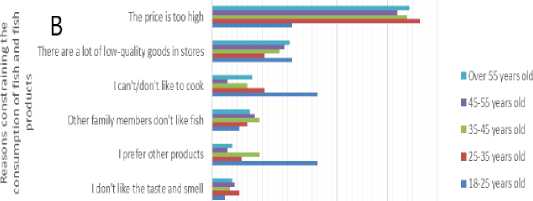
0% 10% 20% 30% 40% 50% 60% 70% 80% 90%
% of respondents
0 50 100 150 200 250 300
Number of respondents
*respondents could choose several answer options in this question
-
Fig. 6. Reasons limiting the consumption of fish and fish products A) distribution of answers for all respondents; B) distribution of answers by age groups of respondents.
The absolute majority of respondents are prevented from consuming fish and fish products in larger quantities than the current one by the high price. For almost a third of respondents, an important aspect is the presence of low or unacceptable quality products in retail trade. An interesting point is that for young people (from 18 to 25 years old), one of the main reasons limiting consumption is the lack of ability and desire to cook.
When purchasing fish and fish products, the majority of residents of the Arctic territories of the region under study give preference to domestic producers, mainly from the Arkhangelsk and Murmansk oblasts. At the same time, only a quarter of respondents practically do not pay attention to the geographical and other affiliation of the manufacturer (Fig. 7).
A
Any Russian manufacturers
I don't pay attention to the manufacturer
Manufacturers of the Murmansk Oblast
Manufacturers of the Far East
Only foreign manufacturers
□ Manufacturers of the Arkhangelsk Oblast
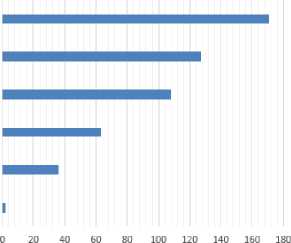
Number of respondents
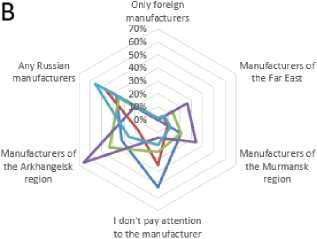
—18-25 years old
—25-35 years old 35-45 years old
«■■"■45-55 years old Over 55 years old
*respondents could choose several answer options in this question
-
Fig. 7. Consumer preferences for producers of fish and fish products A) distribution of answers for all respondents; B) distribution of answers by age groups of respondents.
Preference for purchasing goods from local producers is given mainly by people aged 35– 55 years. The profile of older people is sharply shifted towards any Russian manufacturers. Most likely, this is due to a decrease in income during retirement. Young people aged 18–35 often do not pay attention to the manufacturer when shopping, being guided by other purchasing criteria (Fig. 7 B). A number of respondents noted that it is very difficult to find a manufacturer from the Arkhangelsk Oblast in stores. Some people catch fish themselves; 68 people (or 17% of respondents) do it to some extent.
The leading position among fish products consumed by respondents is occupied by smoked fish, canned fish and preserves are in the second place, and vacuum-packed fish is in the third place (Fig. 8).

*respondents could choose several answer options in this question
-
Fig. 8. Purchase of fish products A) distribution of answers among all respondents; B) distribution of answers by age groups of respondents.
It should be noted that respondents who chose the answer “none of the above” do not consume fish products as a matter of principle, but buy only fresh fish and cook it. Consumer profiles (Fig. 8 B) by age of respondents have some differences. For example, people aged 25–45 years prefer ready-made fish dishes, and young people aged 18–25 years have a preference for consuming dried fish. At the same time, almost 59% of respondents usually spend up to 1 thousand rubles per month of their household income on fish products, and 85% of respondents spend more than 1 thousand rubles per month on fresh fish (Fig. 9).

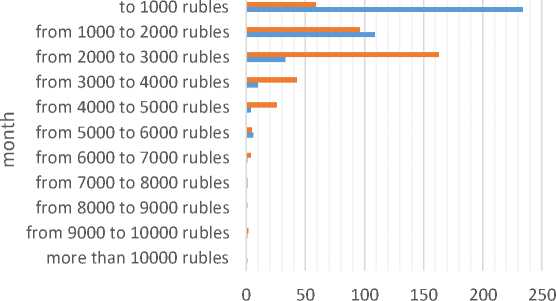
■ Fish
■ Fish products
Number of respondents
Fig. 9. Average household expenditure on fish and fish products per month, thousand rubles.
It should also be noted that the leading answer of the urban population on the issue of average expenditure on fish and fish products is the option “from 2 to 3 thousand rubles per month”, and among the rural population the prevailing answer is “from 1 to 2 thousand rubles”, which indicates a lower level of income and the possibility of independent fishing. At the same time, the majority of residents of both rural and urban areas are ready to spend no more than 1 thousand rubles per month on fish products.
Key challenges and opportunities for the development of aquaculture projects in the Arkhangelsk Oblast: expert community opinion
The development of the fishing industry, including aquaculture production, is one of the priority areas of economic development, which is reflected in a number of strategic planning documents at the federal 8 and regional levels 9. For example, one of the objectives of subprogram No. 2 “Development of the fishery complex of the Arkhangelsk Oblast” of the state agricultural development program 10 is to create conditions for the sustainable development of aquaculture. Thus, aquaculture production (mainly trout farming) in the Arkhangelsk Oblast increased by more than 2.5 times in the period 2010–2022 (Fig. 10). However, as practice has shown, the development of this type of activity is associated with a certain set of problems and difficulties, the views on which among various representatives of the expert community of the Arkhangelsk Oblast often not only do not coincide, but are sometimes in opposite planes (Table 3). The interview involved 9 experts whose activities are directly related to the development of fish farming (aquaculture projects) both from the production process and scientific component, and from the position of government authorities responsible for supporting this area in the region.
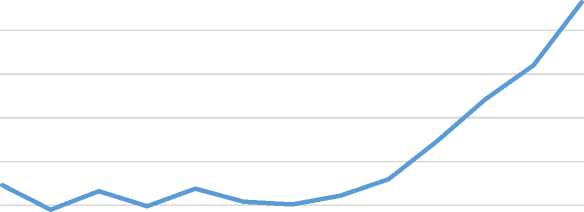
(Л 200
с о
I- 150
2010 2011 2012 2013 2014 2015 2016 2017 2018 2019 2020 2021 2022
Year
Fig. 10. Aquaculture production in the Arkhangelsk Oblast, tons 11.
Table 3
Matrix of expert community opinions on identifying problems of aquaculture project development in the
Arkhangelsk Oblast 12
|
Problem |
Representatives of government authorities and business support institutions |
Representatives of enterprises |
Representatives of scientific community |
|
Poor development (in some cases lack of) infrastructure |
Lakes suitable for fish farming have difficult (or no) transport accessibility |
Problems with logistics (high transport costs). Many potential consumers are located far from aquaculture production sites |
Lack of transport and energy infrastructure is a factor constraining the development of fishery activities in the region |
|
High costs of energy resources, including the use of recirculating water supply (RWS) installations in fish farming. |
For the cage aquaculture method, high energy costs are less problematic than for RWS. However, in the near future, most districts of the region will be gasified, which will remove a number of difficulties caused by the high costs of electricity for RWS |
High energy tariffs are one of the main problems, even though the cage method of cultivation is used |
The problem exists, but its impact is overestimated, since most fish farms in the region do not use RWS, but the cage method of growing aquaculture, which, in comparison with RWS, is less energy-intensive |
|
Technological problems |
The problem with the purchase of foreign feed is solved by import substitution |
Russian feed is significantly inferior in quality to foreign analogues |
There are no serious technological problems |
|
Need for innovations, including renewal of fixed assets |
This area currently does not need innovation |
Innovations are necessary both in technological, marketing and other aspects. An enterprise may lose its competitiveness without them |
This area currently does not need innovation |
|
Environmental restrictions and threats |
There are no obvious problems in terms of ecology and environment |
Cage fish farming causes significant harm to the environment, especially when located on lakes that are sources of drinking water for the local population |
|
|
Inconsistency of opinions regarding the prospects for fish farming and aquaculture development projects in the region |
Recirculating water supply (RWS) installations are promising for the development of aquaculture projects |
The fishing industry of the Arkhangelsk Oblast should be primarily focused on catching and processing fish, and not on growing it |
|
|
Lack of government support |
There is no problem. State support is provided in sufficient volume |
Current support measures are only sufficient to maintain current production volumes. State support is clearly not enough to expand the range of aquaculture species produced, increase volumes, and create new aquaculture enterprises. |
Along with increasing subsidies, coordination and informing the economically active population about the possibilities of creating a business in the field of fish farming (aquaculture) is needed. Currently, new entrepreneurs in this field need professional competencies |
|
Lack of professional competencies and interest from existing entrepreneurs and the younger generation in the implementation of projects |
Lack of talented, professionally trained and motivated young people |
The problem is the quality of education and the mismatch between the level of specialists’ training and the requirements of employers |
Not good enough conditions for the younger generation to create their own entrepreneurial projects |
Basically, the interview questions touched upon the problems of developing aquaculture projects in the Arkhangelsk Oblast, which the experts identified as following: poor development (in some cases, absence) of infrastructure; high energy costs, including when using recirculating water supply (RWS) installations in fish farming; technological problems; need for innovation, including updating fixed assets; environmental restrictions and threats; inconsistency of opinions regarding the prospects of fish farming and aquaculture development projects in the region; insufficient government support; lack of professional competencies and interest among existing entrepreneurs and the younger generation in implementing projects.
Experts — representatives of fish farming enterprises — noted that one of the favorable factors for the development of trout farms is the constant demand of the region’s population for the products of local producers due to existing consumption traditions. However, the development of fish farming is hampered by the high cost of production, especially taking into account the fact that 60–65% of these costs consist of expenditures of fish farming enterprises on imported feed. It is well known that Norway has been the leader in the production of aquaculture feed in the Nordic countries, but the owners of local trout farms are faced with a similar problem [11, Aas T.S., Åsgård T., Ytrestøyl T.].
An analysis of interviews with production experts showed that aquaculture projects based on recirculating water supply (RWS) technology currently have one serious problem — the high cost of energy resources. At the same time, the advantage of RWS is the ability to artificially create favorable climatic conditions for the process of reproduction and population growth (the optimal room temperature should be 15–17°C). It should be noted that the opinion of production experts regarding the personnel problem is that the region should pay attention to the quality of training of specialists for the fishing industry.
Personnel issues related to the availability of specialists of a certain profile and the level of their training did not leave any of the experts indifferent. It is important to note here that, according to the latest data, not only the fishing industry, but also the economy of the Arkhangelsk Oblast as a whole is experiencing a personnel shortage 13. The Higher School of Fisheries and Marine Technologies of NArFU named after M.V. Lomonosov takes an active part in training relevant personnel for fishing activities in the region.
Experts — representatives of the scientific community — noted that the future of the fishing industry of the Arkhangelsk Oblast should not be associated with the artificial cultivation of fish, but primarily with its catching and processing. This is confirmed by the opinion of our colleagues that the North and the Arctic are rich in aquatic biological resources that only need to be used correctly [12, Novoselov A.P., Lukina V.A., Matveev N.Yu., Matveeva A.D.; 13, Tortsev A.M., Studenov I.I.].
Separately, it is necessary to emphasize environmental limitations and threats, since experts —representatives of the scientific community — noted that: “... A trout cage farm of 100 tons produces the same amount of pollutants as a village of 7 thousand inhabitants...”. The possible negative impact of fish farming (aquaculture) enterprises on the environment and the need to assess the corresponding environmental risks are discussed in detail in a number of studies by foreign scientists [14, D’Orbcastel E., Blancheton J.-P., Aubin J.; 15, Chen X., Samson E., Aurélien T., Aubin J.]. However, along with the above, the important role of the socio-economic component of aquaculture development projects cannot be neglected. Best practices in various legal and other economic conditions have been implemented in Northern Norway and Alaska [16, Raspotnik A., Rottem Vigeland S., Osthagen A.], as well as in the Republic of Karelia of the Russian Federation [17, Sterligova O.P., Kuchko Ya.A., Savosin E.S., Ilmast N.V.; 18, Kuritsyn A.E., Makarova T.A., Efremov S.A.].
In addition to the problems described above, representatives of the expert community note the presence of transformations in the culture of consumption and cooking of fish and fish products, which are observed not only in the Arkhangelsk Oblast and in the Arctic zone of the Russian Federation, but also in Russia as a whole. For example, young generations are changing their gastronomic preferences from traditional to simpler and more accessible, which in some cases is due to the significant role of the public catering system.
The interviews with experts also touched upon some problems of the fishery complex in general. One of the representatives of business support institutions in the region said: “... The problems of fishing need to be judged from different levels: in ocean fishing the problem is quotas, in coastal fishing — the dilapidation of villages, and in the inland (regional, local) we have almost no one catches...”. The expert, a representative of government authorities, noted that currently at the regional level there are significant violations of the “catch - sale - consumption” chain, manifested, on the one hand, in the lack of interest of most trading companies, especially federal chains, to enter into contracts with local producers due to the impossibility of stable and significant supplies of fish and fish products (as well as the presence of financial interest in discounts from large suppliers), and on the other hand, due to the presence of certain difficulties for local producers in storing and selling their products, which means that the demand of the population for food products on the local market is not fully met.
The solution to the identified pool of problems of aquaculture projects in such a northern region as the Arkhangelsk Oblast (part of which belongs to the Arctic zone of the Russian Federation), in our opinion, should be comprehensive in nature, have an appropriate basis in terms of consolidating activities in regional programs, departmental documents, strategic documents planning, etc. In this case, the main attention should be paid to the development of transport, logistics and energy resource components aimed at achieving the socio-economic goals of territorial development [19, p. 240; 20, Tutygin A.G., Chizhova L.A., Lovdin E.N., p. 183].
Table 4 provides a brief overview of some possible areas of management decisions and examples of such decisions made in the current conditions of high volatility of environmental factors that contribute to the development of aquaculture projects and the fishery complex of the Arkhangelsk Oblast.
Table 4
Ways and examples of solving problems of aquaculture projects in the Arkhangelsk Oblast
|
Problem |
Ways and methods of solution |
Examples from modern practice of managerial decision-making |
|
Poor development (in some cases lack of) infrastructure |
Creation of an infrastructure (transport and logistics) framework for existing and potential fish farming (aquaculture) projects |
There are no effective examples of solutions in the region * |
|
High costs of energy resources, including the use of recirculating water supply (RWS) installations in fish farming. |
Subsidizing energy costs |
There are no effective examples of solutions in the region * |
|
Purchase of feed |
Creation of a regional food supply base |
On 23 December 2022, a feed production facility was opened at the campus of the Higher School of Fisheries and Marine Technologies |
|
of the Northern (Arctic) Federal 14 University |
||
|
Need for innovations, including renewal of fixed assets |
Priority state support for enterprises investing in the renewal of fixed assets and the introduction of modern production technologies. Lobbying and promotion of local goods in the regional consumer market |
Since 2022, subsidies for equipment for aquaculture projects are availa- 15 ble |
|
Environmental restrictions and threats |
Monitoring of compliance with environmental standards and requirements by fish farms |
There are no effective examples of solutions in the region * |
|
Lack of government support |
Revision of principles and types of state support for the development of aquaculture projects |
Increase subsidies for aquaculture projects by 25% in 2022 (compared to the previous period) |
|
Lack of professional competencies and interest from existing entrepreneurs and the younger generation in aquaculture projects |
Monitoring of staffing needs of employers and compliance of professional competencies of graduates of specialized institutions in the region. Introduction of modern teaching methods into the practice of training specialists |
In 2023, a new higher education program “Aquatic Bioresources and Aquaculture” was introduced on the basis of the Higher School of Fisheries and Marine Technologies of Northern Federal University 16 |
* according to the authors
According to Table 4, the Arkhangelsk Oblast practice lacks effective examples of solutions to such problems of aquaculture project development as: poor infrastructure development, high energy costs, environmental constraints and threats. Therefore, it is currently necessary to consolidate the efforts of authorities, entrepreneurs and the expert community to elaborate measures that will promote the development of activities in the field of aquaculture and increase the economic returns from existing fish farms in the region.
Conclusion
As the historical overview of the socio-economic development of the Arctic regions of Russia in general and the Arkhangelsk North in particular shows, fishing and industry play a very important role both in terms of food security of the population and in the formation of economic relations in the regional economic system. The heyday of the fishing industry of the Arkhangelsk Oblast was in the Soviet period of the 1980s, when the volume of fish catching and production of other aquatic biological resources was about 340 thousand tons per year. Over the past 15 years, in the Arkhangelsk Oblast, unlike other regions of the Russian Arctic, there has been a decrease in the number of fishing and fish farming enterprises. The volume of fish catches also decreased significantly (almost three times) compared to the peak period of the 1980s. Currently, one of the priority tasks of regional state policy is the development of the fishery complex, including ensuring the production of aquaculture.
Within the framework of the research to identify problems and opportunities for the development of the relevant sector of the consumer market of fish and fish products of local pro-
SOCIAL AND ECONOMIC DEVELOPMENT
Lyudmila A. Chizhova, Anna I. Khadyko. Development of Aquaculture in the Northern … ducers on the example of Arctic municipalities of the Arkhangelsk Oblast, the authors conducted a consumer survey and a number of expert interviews with producers of these products, as well as with representatives of the scientific community and authorities. The survey results made it possible to establish different consumer preference profiles of the population depending on their age category. The main reasons limiting the consumption of fish and fish products have been identified, including high prices, the presence of low-quality fish and fish products in retail outlets, as well as the lack of ability and desire to cook among the younger generation.
An analysis of expert opinions made it possible to identify such problems in the development of aquaculture projects in the Arkhangelsk Oblast as:
-
• poor development (sometimes absence) of infrastructure;
-
• high energy costs when using recirculating water supply (RWS) installations in fish farming;
-
• technological problems;
-
• necessity of innovation, including renewal of fixed assets;
-
• environmental restrictions and threats;
-
• insufficient government support;
-
• lack of professional competencies and interest among existing entrepreneurs and the younger generation in implementing projects.
Despite the existing positive examples from the practice of developing aquaculture in Russia and beyond, Arkhangelsk experts (representatives of government authorities, business and the scientific community) have a discrepancy in opinions regarding the prospects for fish farming and aquaculture development projects in the region. According to representatives of the scientific community, the fishing industry of the Arkhangelsk Oblast should focus on catching and processing fish, and not on its artificial cultivation, which is too costly and associated with a number of environmental risks. This issue is certainly debatable and requires further research, especially taking into account the factors of instability of the external environment and the need to increase the sustainability of regional food systems in the face of sanctions pressure [21, p. 353].
Solving a number of problems in aquaculture projects in the Arkhangelsk Oblast could be facilitated by consolidating the efforts of authorities, entrepreneurs and the expert community to develop effective management solutions aimed at developing the activities of fish farms.
Список литературы Development of Aquaculture in the Northern and Arctic Territories: Problems and Solutions (On the Example of the Arkhangelsk Oblast)
- Kozenko Z.N., Kozenko K.Yu., Vorobiev N.N. Prudovaya akvakul'tura kak faktor ustoychivogo razviti-ya sel'skikh territoriy [Pond Aquaculture as Factor of Rural Sustainable Development]. Ekonomika i upravlenie: problemy, resheniya [Economics and Management: Problems, Solutions], 2019, vol. 9, no. 2, pp. 51–57.
- Ermakova N.A., Mikheles T.P. O roli akvakul'tury v sovremennoy paradigme razvitiya sel'skikh terri-toriy i merakh gosudarstvennoy podderzhki predpriyatiy akvakul'tury [On the Role of Aquaculture in the Modern Paradigm of Rural Development and Tools for Aquaculture Support]. Rybnoe kho-zyaystvo [Fisheries], 2016, no. 3, pp. 76–79.
- Ivanov V.A. Severnaya i arkticheskaya spetsifika resheniya problemy prodovol'stvennoy bezopas-nosti [The Northern and Arctic Specifics of Solving the Problem of Food Security]. Sever i rynok: formirovanie ekonomicheskogo poryadka [The North and the Market: Forming the Economic Or-der], 2022, no. 1 (75), pp. 58–71. DOI: 10.37614/2220-802X.1.2022.75.005
- Sukhanov G.G., Sukhanov S.G. Doctrine on Food Security of Russia: Socio-Economic and Socio-Biological Aspects of Its Implementation in the Arctic. Arktika i Sever [Arctic and North], 2021, no. 44, pp. 212–222. DOI: 10.37482/issn2221-2698.2021.44.212
- Moriarity R.J., Liberda E.N., Tsuji L.J.S. Subsistence Fishing in the Eeyou Istchee (James Bay, Quebec, Canada): A Regional Investigation of Fish Consumption as a Route of Exposure to Methylmercury. Chemosphere, 2020, vol. 258, 127413. DOI: 10.1016/j.chemosphere.2020.127413
- Hjellnes V., Rustad T., Falch E. The Value Chain of the White Fish Industry in Norway: History, Cur-rent Status and Possibilities for Improvement – A Review. Regional Studies in Marine Science, 2020, vol. 36, 101293. DOI: 10.1016/j.rsma.2020.101293
- Tutygin A.G., Chizhova L.A., Urykov V.A. Industrial Policy and Transformation of the Consumer Mar-ket of the Russia’s Arctic Regions. Arktika i Sever [Arctic and North], 2022, no. 48, pp. 75–90. DOI: 10.37482/issn2221-2698.2022.48.75
- Lobanov K.V., Chicherov M.V. Osvoenie prirodnykh resursov Arkticheskoy zony Rossii v X–XVII vekakh [Development of the Natural Resources in the Arctic Zone of Russia in X-XVII Centuries]. Izvestiya vysshikh uchebnykh zavedeniy. Geologiya i razvedka [Proceedings of Higher Educational Es-tablishments. Geology and Exploration], 2017, no. 3, pp. 40–47. DOI: 10.32454/0016-7762-2017-3-40-47
- Sokolova O.M., ed. Pomorskaya entsiklopediya. V 5 t. T. 3. Ekonomika Arkhangel'skogo Severa [The Pomor Encyclopedia. Vol. 3. Economics of the Arkhangelsk North]. Arkhangelsk, ASTU Publ., 2006, 636 p. (In Russ.)
- Devyatko I.F. Metody sotsiologicheskogo issledovaniya [Methods of Sociological Research]. Yekate-rinburg, Izdatel'stvo Ural'skogo universiteta Publ., 1998, 208 p. (In Russ.)
- Aas T.S., Aasgaard T.E., Ytrestøyl T. Utilization of Feed Resources in the Production of Rainbow Trout (Oncorhynchus Mykiss) in Norway in 2020. Aquaculture Reports, 2022, vol. 26, 101317. DOI: 10.1016/j.aqrep.2022.101317
- Novoselov A.P., Lukina V.A., Matveev N.Yu., Matveeva A.D. Biologicheskaya kharakteristika ikhtiofauny ust'evoy oblasti reki Severnaya Dvina [Biological Characteristics of the Fish Fauna in the Severnaya Dvina Estuarine Area]. Trudy Karel'skogo nauchnogo tsentra RAN [Proceedings of the KRC RAS], 2022, no. 3, pp. 82–96. DOI: 10.17076/eco1570
- Tortsev A.M., Studenov I.I. Promyshlennoe rybolovstvo v usloviyakh rasshireniya granits osobo okhranyaemykh prirodnykh territoriy v Arkhangel'skoy oblasti [Commercial Fishery in the Context of the Expansion of Protected Natural Areas in the Archangel Region]. Vestnik Altayskoy akademii ekonomiki i prava [Bulletin of the Altai Academy of Economics and Law], 2020, no. 5-2, pp. 346–351. DOI: 10.17513/vaael.1150
- d’Orbcastel E.R., Blancheton J.-P., Aubin J. Towards Environmentally Sustainable Aquaculture: Com-parison between Two Trout Farming Systems Using Life Cycle Assessment. Aquacultural engineer-ing, 2009, vol. 40 (3), pp. 113–119. DOI: 10.1016/j.aquaeng.2008.12.002
- Chen X., Samson E., Aurélien T., Aubin J. Environmental Assessment of Trout Farming in France by Life Cycle Assessment: Using Bootstrapped Principal Component Analysis to Better Define System Classification. Journal of Cleaner Production, 2015, vol. 87 (1), pp. 87–95. DOI: 10.1016/j.jclepro.2014.09.021
- Raspotnik A., Rottem S.V., Østhagen A. The Blue Economy in the Arctic Ocean: Governing Aquacul-ture in Alaska and North Norway. Arktika i Sever [Arctic and North], 2021, no. 42, pp. 122–144. DOI: 10.37482/issn2221-2698.2021.42.122
- Sterligova O.P., Kuchko Ya.A., Savosin E.S., Ilmast N.V. Perspektivy vyrashchivaniya ob"ektov ak-vakul'tury v ozerakh Karelii [Prospects of Cultivation of Aquaculture Objects in the Lakes of Karelia]. Voprosy rybolovstva [Problems of Fisheries], 2019, vol. 20, no. 2, pp. 216–224.
- Kuritsyn A.E., Makarova T.A., Efremov S.A. Analiz razvitiya akvakul'tury v Respublike Kareliya [An Analysis of Aquaculture Development in Republic of Karelia]. Rybnoe khozyaystvo [Fisheries], 2015, no. 2, pp. 83–87.
- Chizhova L.A., ed. Sotsial'no-ekonomicheskoe razvitie arkticheskogo makroregiona: kompleksnyy podkhod: monografiya [Socio-Economic Development of the Arctic Macroregion: A Comprehensive Approach]. Arkhangelsk, KIRA Publ., 2022, 292 p. (In Russ.)
- Tutygin A.G., Chizhova L.A., Lovdin E.N. Assessment of the Socio-Economic Situation in the Arctic Municipal Districts of the Arkhangelsk Oblast Based on the Target Model. Arktika i Sever [Arctic and North], 2022, no. 46, pp. 141–156. DOI: 10.37482/issn2221-2698.2022.46.170
- Lavrikova Yu.G., ed. Riski i vozmozhnosti razvitiya regionov Rossii v usloviyakh sanktsionnogo davleniya: monografiya [Risks and Opportunities for the Development of Russian Regions under Sanctions Pressure]. Institute of Economics UB RAS Publ., 2022, 644 p. (In Russ.)

